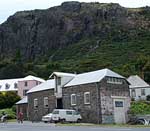Having the opportunity as a youngster to spend my summers in the forests and lakes of Northern Michigan I'm sure has affected what I'm doing right now. I remember being in the forest and playing with sticks, assembling them, and liking the feeling of being with the trees.
Wood designer-maker Toby Muir-Wilson

My workshop is on part of the family farm and I've lived alongside it or near it all my life apart from the occasions where I've been studying or working overseas or interstate.
My dad had an interest in wood turning and I used to wood turn things for him to make pocket money. This was back in the 60s so effectively I've been making and selling woodwork now for thirty-five years.

I had two years of intensive training at John Makepiece's school in England. I was one of the first overseas students. It was only the second year of the course and I think with the exception of one person, all of us are still making a living as designer-makers, twenty odd years on.
The thing I find frustrating about being a furniture maker is that you are working with large pieces that sometimes take days, sometimes weeks or months. You really get envious of a potter who can sit there at a wheel and throw half a dozen forms and develop a theme in the one kiln firing.
In woodwork the only way I have found to solve this problem is to make small decorative boxes that I sell and make for exhibitions and I try out decorative themes on the boxes. If I find that satisfying or there's a reaction which indicates that I'm on the right track, I'll develop that through and scale that up to a slightly larger piece of furniture like a coffee table then finally it's scaled right up to be an interior installation or a dining suite. My jewelry boxes are my models.
There are elements of being in Tasmania which are really important. I hesitate at using the word unique. We have a range of temperate climate timbers which are interesting to work with because they cover a variety of things within cabinet making such as soft timber, hard timber, good for carving, a range of colours from pure white through to red to almost jet black. Then there are those greens, oranges, pinks. You've got a whole palette of colour to work with.
We've got the full range of allergies to timbers too. I think everyone's allergic to blackwood! Some of those considerations are quite important because I now look at the finishes I'm using on timber and whether they're compatible with my health.
I tend to avoid anything to do with petrochemicals if I can and use organic finishes. There's two reasons for that – in twenty years time I know that you can restore them easily whereas with plastics you've got to know the history of it to restore it well.
One of the principles I usually stick to is I find a simple geometric shape that encompasses a functional design, then I find one key element to decorate it. The decoration is often semi-functional and drawn from the environment around me, like a river form. It's like when you're bushwalking, you see different points of the landscape moving against each other and you can bring that to furniture.
Related
I'm a self-taught wood turner. That didn't satisfy me in some way, there was something missing. So I toddled off to the Canberra School of Art and spent a couple of years there doing a furniture-based wood course.
I turned to furniture mid-career. I was actually trained as a musician and a high school teacher and I decided to do something else. I'd done a lot of building before and I suddenly decided to build stuff that I was going to sell instead of keep.
About fifteen years ago I bought a little house that I was going to renovate but I could never find anyone to do things exactly as I wanted them.
I was born in Melbourne and I've been in Tasmania for about 14 years. I like Tasmania because I like the bush, I like the weather, I like the timber. It's a much more natural environment than the mainland. The landscape here is inspirational to my work.
I was born in Tasmania. My father was in the timber industry so I was always surrounded by stories of timber and things like that. I left school at 14 to do a trade in joinery. Prior to that I was more interested in making boats.
I came to Australia in 1970 to take up a teaching position at the Tasmanian School of Art. We were probably some of the last of the Ten Pound Poms. I was very keen after going through college in the UK to travel overseas and try other cultures.
I remember carving when I was about 8. I used to steal my mum's lino carving tools. I was able to go down to the workshop in the garage and carve away. I think the first thing I came up with was an acanthus leaf. I was really pleased with that.








